Enhanced Adsorption of Arsenate from Contaminated Waters by Magnesium-, Zinc- or Calcium-Modified Biochar—Modeling and Mechanisms
Abstract
1. Introduction
2. Materials and Methods
2.1. Raw Material and Pretreatment
2.2. Production of the Adsorbent and Characterization

2.3. Arsenate Adsorption Experiments
2.4. Equilibrium and Adsorption Modelling
3. Results and Discussion
3.1. Properties of Non-Modified and Modified Adsorbent Materials
3.2. Kinetics of Arsenate Adsorption
3.3. Arsenate Adsorption Capacity of AS Biochar
3.4. Equilibrium of Arsenate Adsorption
3.5. Mechanisms of Arsenate Adsorption
4. Conclusions
Author Contributions
Funding
Data Availability Statement
Acknowledgments
Conflicts of Interest
References
- Yu, Z.; Zhou, L.; Huang, Y.; Song, Z.; Qiu, W. Effects of a manganese-oxide-modified biochar composite on adsorption of arsenic in red soil. J. Environ. Manag. 2015, 163, 155–162. [Google Scholar] [CrossRef] [PubMed]
- Braghiroli, F.L.; Calugaru, I.L.; Merchan, C.G.; Neculita, C.M.; Bouafif, H.; Koubaa, A. Efficiency of eight modified materials for As (V) removal from synthetic and real mine effluents. Miner. Eng. 2020, 151, 106310. [Google Scholar] [CrossRef]
- Xia, D.; Tan, F.; Zhang, C.; Jiang, X.; Chen, Z.; Li, H.; Zheng, Y.; Li, Q.; Wang, Y. ZnCl2-activated biochar from biogas residue facilitates aqueous As (III) removal. Appl. Surf. Sci. 2016, 377, 361–369. [Google Scholar] [CrossRef]
- Zhu, N.; Yan, T.; Qiao, J.; Cao, H. Adsorption of arsenic, phosphorous and chromium by bismuth impregnated biochar: Adsorption mechanism and depleted adsorbent utilization. Chemosphere 2016, 164, 32–40. [Google Scholar] [CrossRef] [PubMed]
- Duan, X.; Zhang, C.; Srinivasakannan, C.; Wang, X. Waste walnut shell valorization to iron loaded biochar and its application to arsenic removal. Res. Effic. Technol. 2017, 3, 29–36. [Google Scholar]
- Liu, Z.; Zhang, F.; Sasai, R. Arsenate removal from water using Fe3O4-loaded activated carbon prepared from waste biomass. Chem. Eng. J. 2010, 160, 57–62. [Google Scholar] [CrossRef]
- Samsuri, A.W.; Zadeh, F.S.; Bardan, B.J.S. Adsorption of As (III) and As (V) by Fe coated biochars and biochars produced from empty fruit bunch and rice husk. J. Environ. Chem. Eng. 2013, 1, 981–988. [Google Scholar] [CrossRef]
- Banerjee, S.; Mukherjee, S.; LaminKa-Ot, A.; Joshi, S.R.; Mandal, T.; Halder, G. Biosorptive uptake of Fe2+, Cu2+ and As5+ by activated biochar derived from Colocasia esculenta: Isotherm, kinetics, thermodynamics and cost estimation. J. Adv. Res. 2016, 7, 597–610. [Google Scholar] [CrossRef]
- Alatalo, S.; Repo, E.; Makila, E.; Salonen, J.; Vakkilainen, E.; Sillanpaa, M. Adsorption behaviour of hydrothermally treated municipal sludge and pulp and paper industry sludge. Biores. Technol. 2013, 147, 71–76. [Google Scholar] [CrossRef]
- Zhang, M.; Gao, B.; Varnoosfaderani, S.; Hebard, A.; Yao, Y.; Inyang, M. Preparation and characterization of a novel magnetic biochar for arsenic removal. Biores. Technol. 2013, 130, 457–462. [Google Scholar] [CrossRef]
- Jin, H.; Capareda, S.; Chang, Z.; Gao, J.; Xu, Y.; Zhang, J. Biochar pyrolytically produced from municipal solid wastes for aqueous As (V) removal: Adsorption property and its improvement with KOH. Biores. Technol. 2014, 169, 622–629. [Google Scholar] [CrossRef] [PubMed]
- Agrafioti, E.; Kalderis, D.; Diamadopoulos, E.J. Ca and Fe modified biochars as adsorbents of arsenic and chromium in aqueous solutions. Environ. Manag. 2014, 146, 444–450. [Google Scholar] [CrossRef] [PubMed]
- Li, Q.; Liang, W.; Liu, F.; Wang, G.; Wan, J.; Zhang, W.; Peng, C.; Yang, J. Simultaneous immobilization of arsenic, lead and cadmium by magnesium-aluminum modified biochar in mining soil. J. Environ. Manag. 2022, 310, 114792. [Google Scholar] [CrossRef] [PubMed]
- Cruz, G.J.F.; Mondal, D.; Rimaycuna, J.; Soukup, K.; Gomez, M.M.; Solis, J.L.; Lang, J. Agrowaste derived biochars impregnated with ZnO for removal of arsenic and lead in water. J. Environ. Chem. Eng. 2020, 8, 103800. [Google Scholar] [CrossRef]
- Chen, M.; Bao, C.; Hu, D.; Jin, X.; Huang, Q. Facile and low-cost fabrication of ZnO/biochar nanocomposites from jute fibers for efficient and stable photodegradation of methylene blue dye. J. Anal. Appl. Pyrolysis 2019, 139, 319–332. [Google Scholar] [CrossRef]
- Vamvuka, D.; Elmazaj, J.; Berkis, M. Enhanced H2 gas production from steam gasification of a winery waste through CO2 capture by waste concrete fines and use of alkali catalysts. Renew. Energy 2023, 219, 119428. [Google Scholar] [CrossRef]
- Jiang, M.; Yang, Y.; Lei, T.; Ye, Z.; Huang, S.; Fu, X.; Liu, P.; Li, H. Removal of phosphate by a novel activated sewage sludge biochar: Equilibrium, kinetic and mechanism studies. Applic. Ener. Comb. Sci. 2022, 9, 100056. [Google Scholar] [CrossRef]
- Hassan, M.; Liu, Y.; Naidu, R.; Parikh, S.J.; Du, J.; Qi, F.; Willett, I.R. Influences of feedstock sources and pyrolysis temperature on the properties of biochar and functionality as adsorbents: A meta-analysis. Sci. Tot. Environ. 2020, 744, 140714. [Google Scholar] [CrossRef]
- Salameh, Y.; Albadarin, A.B.; Allen, S.; Walker, G.; Ahmad, M.N.M. Arsenic (III, V) adsorption onto charred dolomite: Charring optimization and batch studies. Chem. Eng. J. 2015, 259, 663–671. [Google Scholar] [CrossRef]
- Shin, H.; Tiwari, D.; Kim, D.J. Phosphate adsorption/desorption kinetics and P bioavailability of Mg-biochar from ground coffee waste. J. Water Process Eng. 2020, 37, 101484. [Google Scholar] [CrossRef]
- Li, J.; Li, B.; Huang, H.; Lv, X.; Zhao, N.; Guo, G.; Zhang, D. Removal of phosphate from aqueous solution by dolomite-modified biochar derived from urban dewatered sewage sludge. Sci. Tot. Environ. 2019, 687, 460–469. [Google Scholar] [CrossRef] [PubMed]
- Li, R.; Wang, J.J.; Zhou, B.; Zhang, Z.; Liu, S.; Lei, S.; Xiao, R. Simultaneous capture removal of phosphate, ammonium and organic substances by MgO impregnated biochar and its potential use in swine wastewater treatment. J. Clean. Prod. 2017, 147, 96–107. [Google Scholar] [CrossRef]

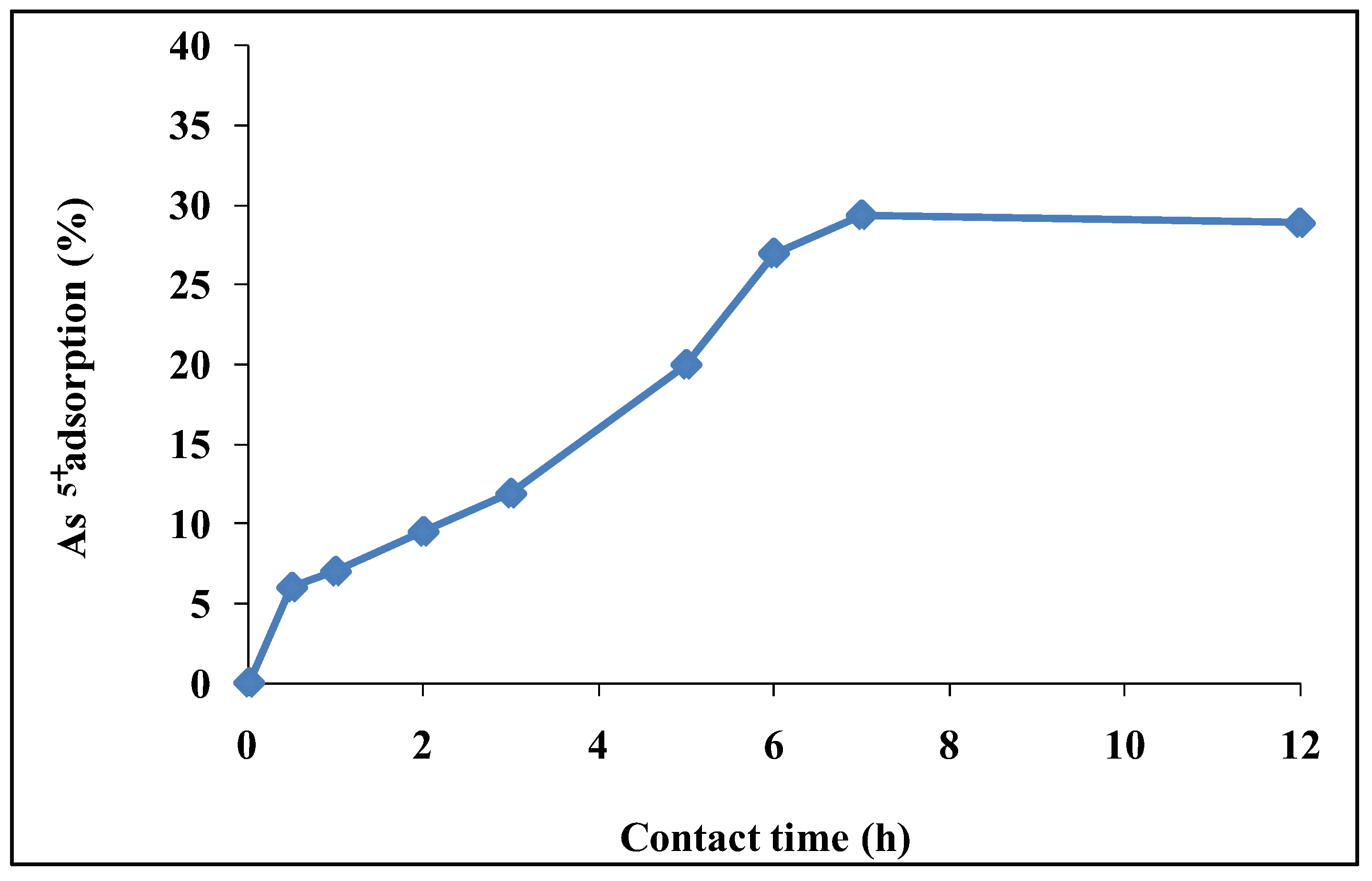

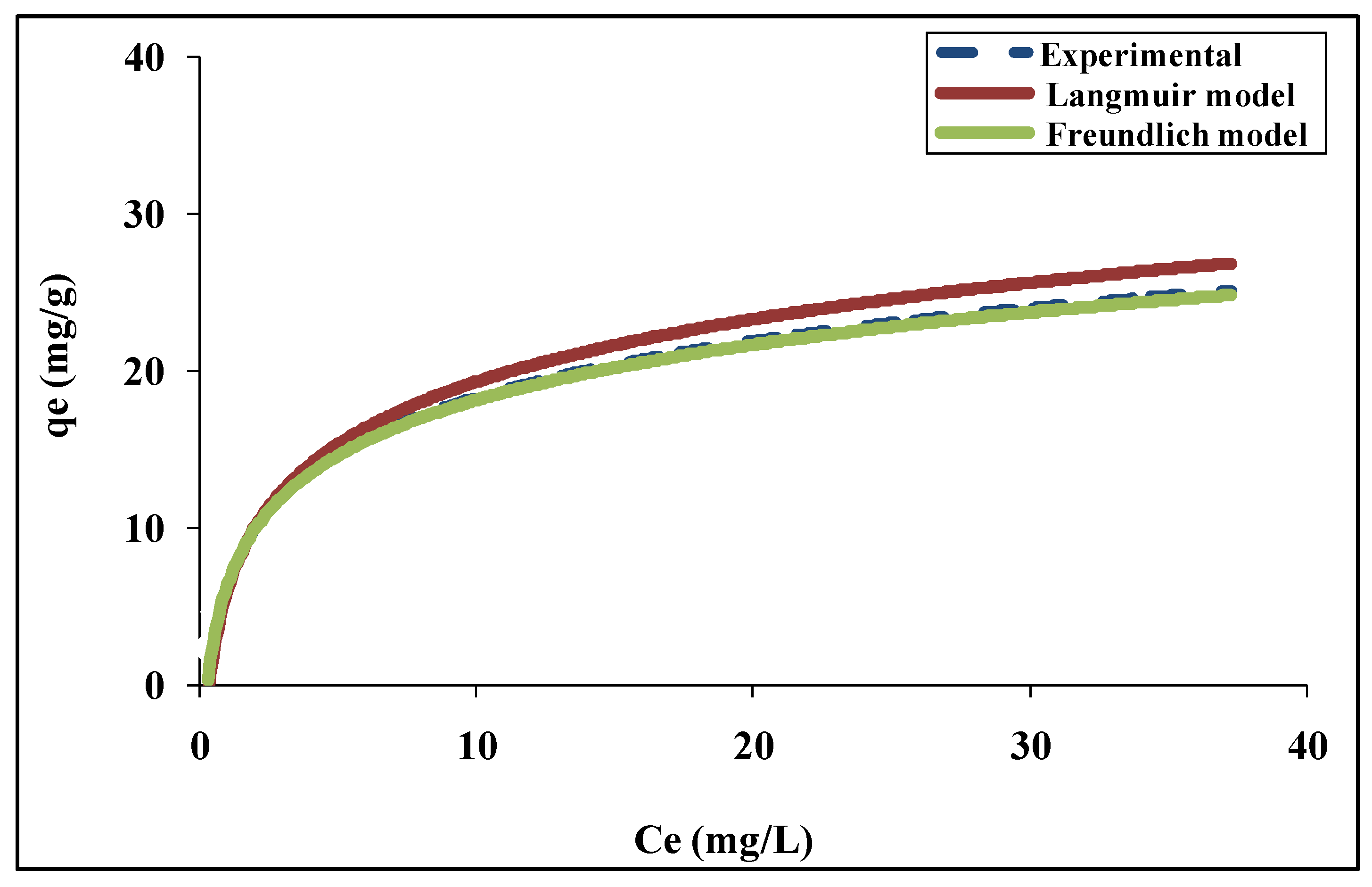
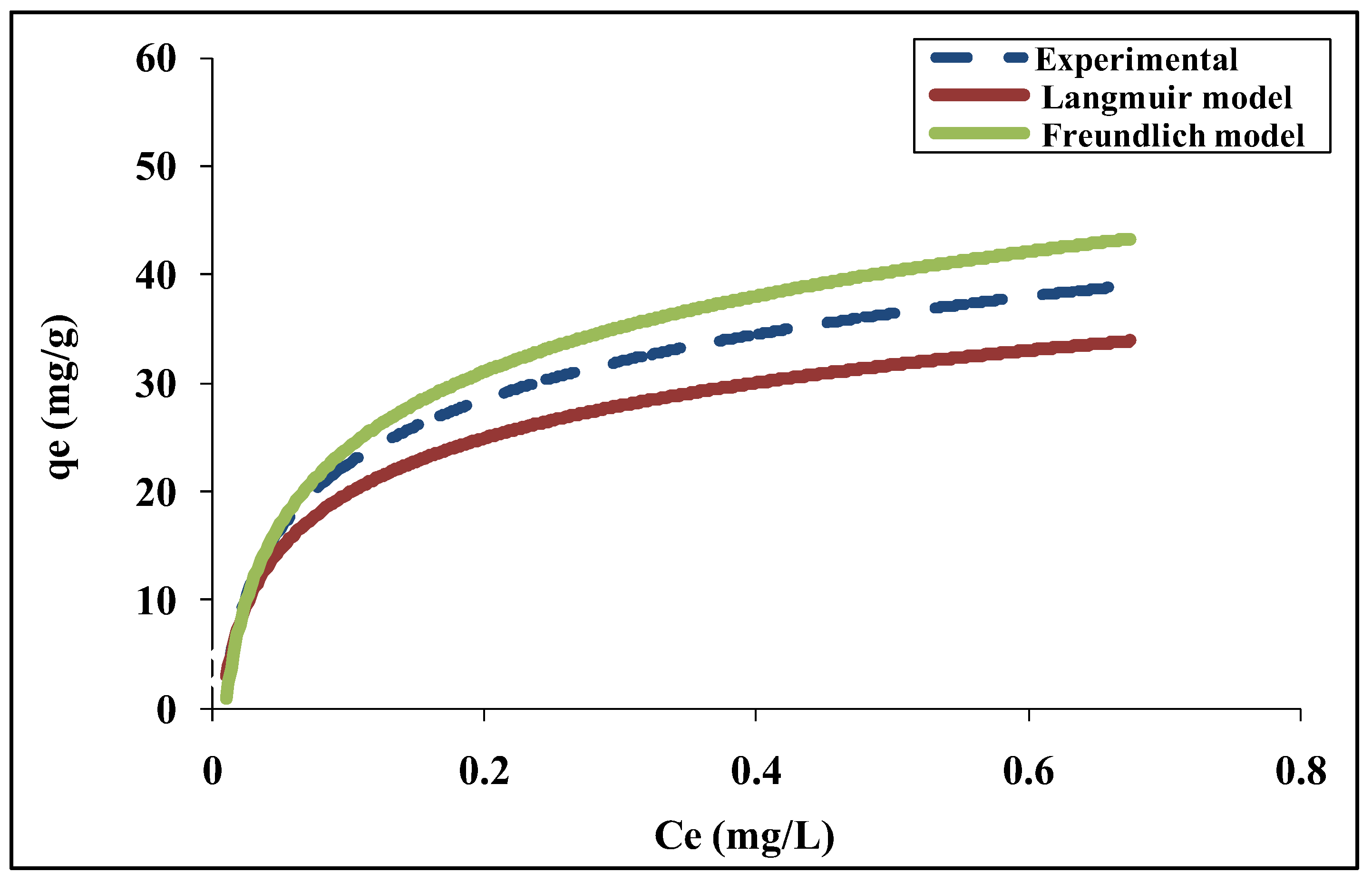
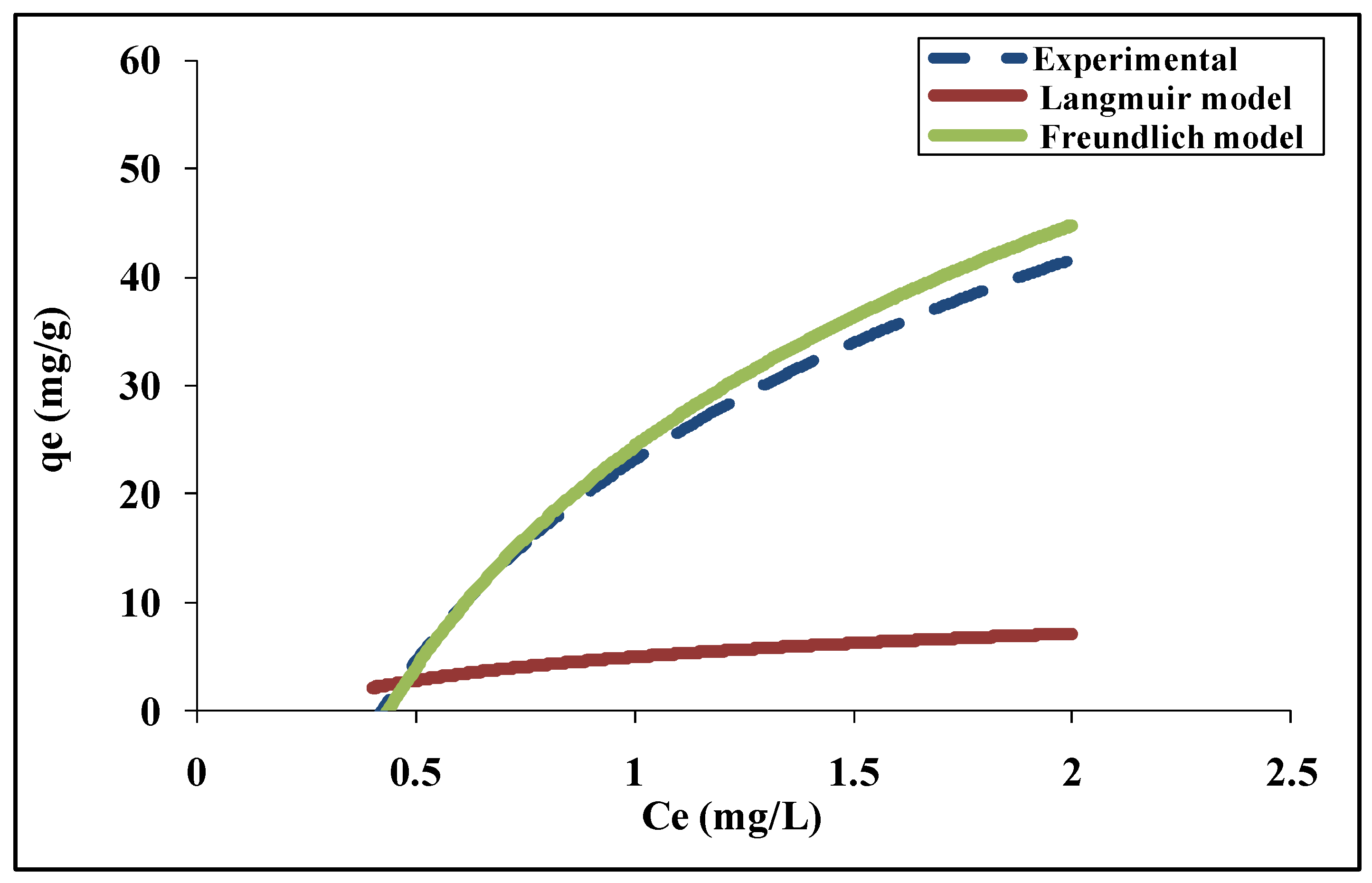
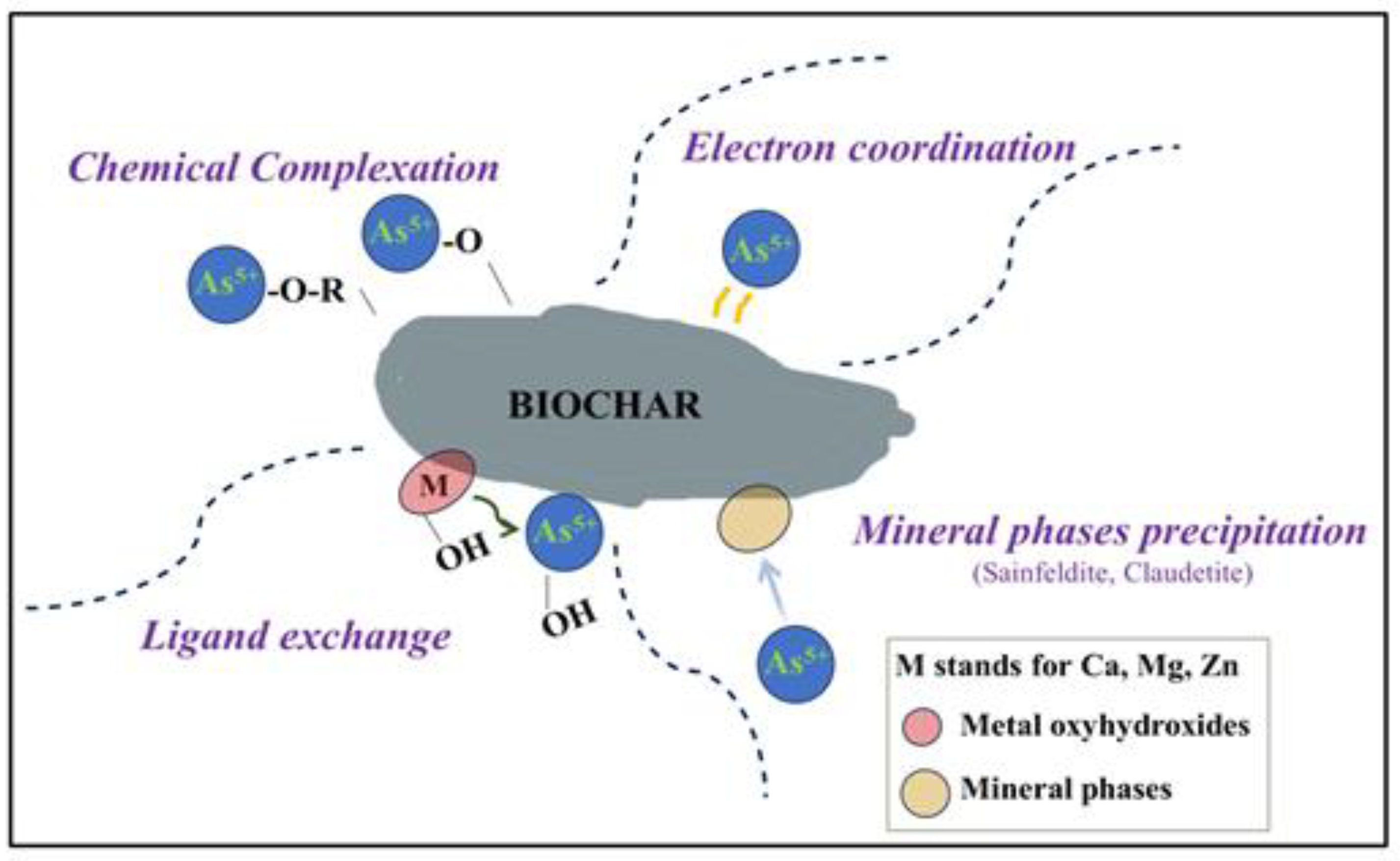
| Fixed Carbon | Ash | C | H | N | O | S | Specific Surface Area (m2/g) | Micropore Volume × 102 (cm3/g) | Average Pore Size(Å) |
|---|---|---|---|---|---|---|---|---|---|
| 97.5 | 2.5 | 66.0 | 1.1 | - | 30.4 | - | 657.0 | 32.9 | 24.0 |
| Modified Biochar | Wave Number (cm−1) | Functional Groups |
|---|---|---|
| ASB-Mg | 434/538 | Mg-O |
| 640/668/854 | As-O/As-OH | |
| 1268 | C-O | |
| 1442 | C-H | |
| 1546/1580 | C=C | |
| 2372 | O=C=O | |
| 3448 | O-H | |
| ASB-Zn | 478/528/652/764/884/916 | Zn-O/Zn-OH |
| 652/884 | As-O/As-OH | |
| 1384 | O-H | |
| 1594/1642 | C=C | |
| 2368 | O=C=O | |
| 3494 | O-H | |
| ASB-Ca | 876 | Ca-O/As-O/As-OH |
| 1084/1144/1150/1294/1302 | C-O | |
| 1426/1438 | O-H | |
| 1588 | C=C | |
| 2354/2376 | O=C=O | |
| 3034/3450/3522/3640 | O-H |
| Kinetic Model Parameters | |||||
|---|---|---|---|---|---|
| Pseudo-First-Order | Pseudo-Second-Order | ||||
| qe (mg/g) | k1 (1/h) | R2 | qe (mg/g) | k2 (1/h) | R2 |
| 0.733 | 0.009 | 0.427 | 0.733 | 0.973 | 0.759 |
| Initial Ion Concentration (mg/L) | Adsorbent Dose 4 g/L | |||||||
|---|---|---|---|---|---|---|---|---|
| Removal Efficiency (%) | pH after Adsorption | |||||||
| ASB | ASB-Mg | ASB-Zn | ASB-Ca | ASB | ASB-Mg | ASB-Zn | ASB-Ca | |
| 5 | 2.2 | 99.9 | 100.0 | 89.0 | 8.02 | 9.97 | 9.58 | 11.19 |
| 10 | 29.3 | 99.1 | 100.0 | 94.0 | 7.89 | 9.65 | 9.34 | 11.85 |
| 25 | 24.4 | 96.0 | 98.5 | 95.8 | 7.90 | 9.60 | 9.17 | 11.77 |
| 50 | 41.2 | 77.0 | 98.4 | 96.2 | 7.96 | 9.56 | 8.90 | 11.63 |
| 75 | 45.2 | 85.0 | 98.0 | 96.7 | 7.99 | 9.46 | 8.78 | 11.58 |
| 100 | 49.4 | 86.0 | 97.0 | 97.0 | 8.04 | 9.33 | 8.71 | 11.48 |
| Adsorbent Dose 2 g/L | ||||||||
| 5 | 2.9 | 94.0 | 100.0 | 92.0 | 7.90 | 10.05 | 9.65 | 11.2 |
| 10 | 30.0 | 93.3 | 100.0 | 95.0 | 7.81 | 9.81 | 9.32 | 11.9 |
| 25 | 31.2 | 82.2 | 99.7 | 97.0 | 7.83 | 9.75 | 9.15 | 11.8 |
| 50 | 45.1 | 64.3 | 98.8 | 97.3 | 7.88 | 9.65 | 8.92 | 11.6 |
| 75 | 46.9 | 63.8 | 99.1 | 97.7 | 7.91 | 9.55 | 8.87 | 11.6 |
| 100 | 50.6 | 62.7 | 99.9 | 98.0 | 7.97 | 9.47 | 8.80 | 11.5 |
| Adsorbent Dose 4 g/L | ||||||
|---|---|---|---|---|---|---|
| Langmuir Model | Freundlich Model | |||||
| Q (mg/g) | b (L/mg) | R2 | k (L/g) | 1/n | R2 | |
| ASB | 12.469 | 0.009 | 0.205 | 0.126 | 1.080 | 0.888 |
| ASB-Mg | 15.528 | 0.945 | 0.773 | 6.092 | 0.331 | 0.941 |
| ASB-Zn | 26.666 | 1.974 | 0.835 | 12.981 | 0.325 | 0.943 |
| ASB-Ca | 20.533 | 0.188 | 0.819 | 5.375 | 1.325 | 0.993 |
| Adsorbent Dose 2 g/L | ||||||
| ASB | 81.301 | 0.585 | 0.508 | 27.327 | 0.698 | 0.810 |
| ASB-Mg | 33.333 | 0.126 | 0.838 | 4.795 | 0.487 | 0.977 |
| ASB-Zn | 39.062 | 9.143 | 0.714 | 66.512 | 0.637 | 0.889 |
| ASB-Ca | 16.0 | 0.416 | 0.602 | 15.170 | 1.800 | 0.973 |
| Feedstock | Activation Method | Adsorbent Dose (g/L) | Arsenate Adsorption Capacity (mg/g) | Reference |
|---|---|---|---|---|
| Empty fruit bunch Rice husk Fe-coated rice husk | Commercial biochar | 5 | 5.5 7.1 16 | [7] |
| Roots of C. esculenta | Nitrogen/steam 700 °C | 0.6 | 2.2 | [8] |
| Corncob ZnO-corncob | Nitrogen 600 °C | 4 | 5 25.9 | [14] |
| MnO-corn straw | Nitrogen 600 °C | 0.5–4 | 14.4 | [1] |
| KOH-MSW | Nitrogen 600 °C | 2 | 31 | [11] |
| Fe-coated walnut shell | Nitrogen microwave | 1 | 1.9 | [5] |
| Fe-coated pine sawdust | Nitrogen 600 °C | 0.2 | 43.7 | [6] |
| Fe-coated cotton wood | Nitrogen 600 °C | 2 | 3.1 | [10] |
| Fe-coated rice husk | Nitrogen 300 °C | 16 | 0.7 | [12] |
| Almond shell Mg/Zn/Ca-almond shell | Nitrogen/steam 700 °C | 2 | 12.4 35/50/49 | This study |
Disclaimer/Publisher’s Note: The statements, opinions and data contained in all publications are solely those of the individual author(s) and contributor(s) and not of MDPI and/or the editor(s). MDPI and/or the editor(s) disclaim responsibility for any injury to people or property resulting from any ideas, methods, instructions or products referred to in the content. |
© 2024 by the authors. Licensee MDPI, Basel, Switzerland. This article is an open access article distributed under the terms and conditions of the Creative Commons Attribution (CC BY) license (https://creativecommons.org/licenses/by/4.0/).
Share and Cite
Vamvuka, D.; Sdoukou, E.; Stratakis, A.; Pentari, D. Enhanced Adsorption of Arsenate from Contaminated Waters by Magnesium-, Zinc- or Calcium-Modified Biochar—Modeling and Mechanisms. C 2024, 10, 61. https://doi.org/10.3390/c10030061
Vamvuka D, Sdoukou E, Stratakis A, Pentari D. Enhanced Adsorption of Arsenate from Contaminated Waters by Magnesium-, Zinc- or Calcium-Modified Biochar—Modeling and Mechanisms. C. 2024; 10(3):61. https://doi.org/10.3390/c10030061
Chicago/Turabian StyleVamvuka, Despina, Elena Sdoukou, Antonios Stratakis, and Despina Pentari. 2024. "Enhanced Adsorption of Arsenate from Contaminated Waters by Magnesium-, Zinc- or Calcium-Modified Biochar—Modeling and Mechanisms" C 10, no. 3: 61. https://doi.org/10.3390/c10030061
APA StyleVamvuka, D., Sdoukou, E., Stratakis, A., & Pentari, D. (2024). Enhanced Adsorption of Arsenate from Contaminated Waters by Magnesium-, Zinc- or Calcium-Modified Biochar—Modeling and Mechanisms. C, 10(3), 61. https://doi.org/10.3390/c10030061







